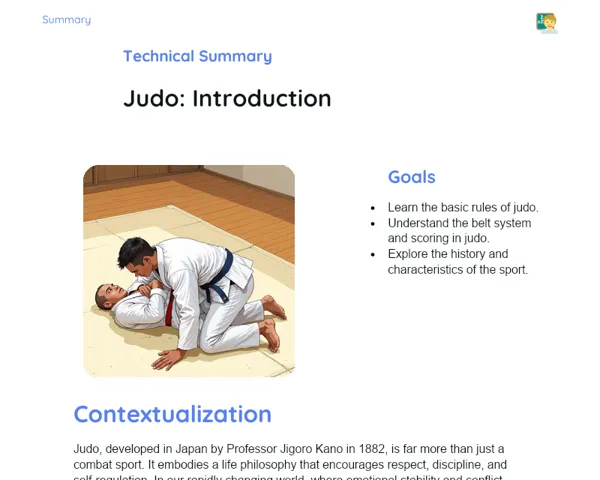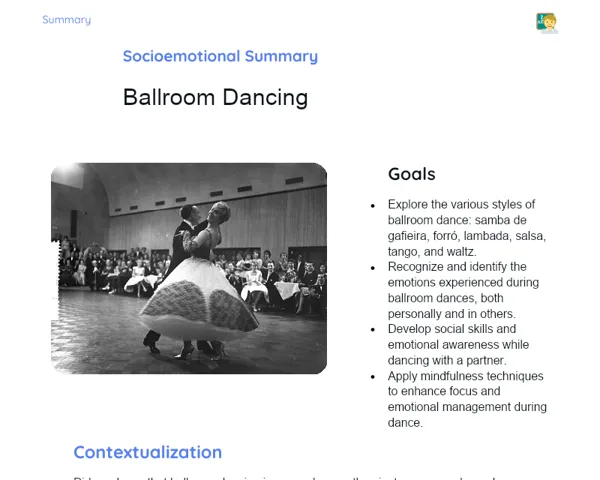Goals
1. Identify the prominent martial arts across the globe and their unique traits.
2. Comprehend the historical evolution of various martial arts.
3. Recognize significant tournaments and competitions in martial arts internationally.
Contextualization
Martial arts form an integral part of the cultural fabric in many nations and boast a rich, diverse heritage. From Karate in Japan to Muay Thai in Thailand, each discipline carries a distinct narrative and specialized techniques that have been honed over centuries. Brazilian Jiu-Jitsu, innovated by the Gracie brothers, serves as a testament to how cultural mingling can lead to the birth of new sporting practices. Grasping the essence of these arts is vital, not just for physical conditioning, but also for acknowledging the cultural and historical significance that each practice encapsulates.
Subject Relevance
To Remember!
History and Origin of Martial Arts
The roots of martial arts can be traced back to ancient civilizations, with evidence spanning thousands of years. Each martial art has its own origin story, often intertwined with the cultural and traditional mores of its homeland. For instance, Karate emerged in Okinawa, Japan, primarily as a form of unarmed self-defense, whereas Muay Thai developed in Thailand as a military combat strategy. Appreciating the origins of these martial arts enriches our understanding of their evolution over time.
-
Karate, meaning 'empty hands', has its origins in Okinawa, Japan.
-
Muay Thai, known as 'the art of eight limbs', utilizes fists, elbows, knees, and shins.
-
Brazilian Jiu-Jitsu was derived from Japanese Jiu-Jitsu by the Gracie brothers in Brazil.
Characteristics and Techniques of Different Martial Arts
Each martial art has its distinctive features and techniques that set it apart from others. Judo emphasizes throws and holds, while boxing is centered around punches. Taekwondo is recognized for its swift and high kicks, whereas Brazilian Jiu-Jitsu specializes in ground combat and submission maneuvers. Recognizing these characteristics is crucial for grasping the practical applications and rules inherent to each martial art.
-
Judo relies on throws, chokes, and holds.
-
Boxing predominantly focuses on punches and evasive movements.
-
Taekwondo is marked by its rapid and high kicks.
Major Tournaments and Competitions in Martial Arts
There are several esteemed tournaments and competitions in martial arts that provide vital platforms for athletes to exhibit their abilities. The UFC (Ultimate Fighting Championship) is among the leading organizations for MMA (Mixed Martial Arts), while the Olympic Games feature disciplines like Judo and Taekwondo. These events not only foster the sport but also help popularize martial arts globally.
-
The UFC stands out as a premier MMA competition.
-
Judo and Taekwondo are included in the Olympic Games.
-
The World Karate Championship is organized by the World Karate Federation (WKF).
Practical Applications
-
Martial arts instructors utilize their understanding of techniques and history to train students in gyms and clubs.
-
Sports coaches employ specific techniques from each martial art to design customized training regimens for athletes.
-
Event organizers are responsible for planning and executing martial arts competitions and tournaments, thereby promoting the sport and fostering public involvement.
Key Terms
-
Karate: A martial art that originated in Okinawa, Japan, involving strikes with hands and feet.
-
Muay Thai: A martial art from Thailand recognized as 'the art of eight limbs', utilizing fists, elbows, knees, and shins.
-
Brazilian Jiu-Jitsu: This is a Brazilian adaptation of Jiu-Jitsu, focusing on ground combat techniques and submissions.
-
Boxing: A combat sport that emphasizes punches for offense and defense.
-
Judo: A traditional Japanese martial art that concentrates on throws, holds, and joint locks.
-
Taekwondo: A traditional Korean martial art celebrated for its swift and high kicks.
Questions for Reflections
-
How do various martial arts cultures influence one another?
-
In what ways can martial arts foster values like discipline, respect, and self-confidence?
-
What opportunities and challenges exist for professionals in martial arts, including instructors and event organizers?
Practical Challenge: Creating a Martial Arts Workshop
Let’s consolidate our learning by designing a mini workshop focused on a specific martial art. This challenge will entail research, practice, and presentation of your chosen martial art, underscoring its core characteristics, techniques, and cultural relevance.
Instructions
-
Form groups of 4 to 5 students.
-
Select a martial art (e.g., Karate, Judo, Muay Thai, etc.).
-
Research the history, techniques, and regulations of your selected martial art.
-
Prepare a 10-minute presentation that comprises:
-
A brief historical overview of the martial art.
-
Demonstration of key techniques and movements (safely and under supervision).
-
Explanation of the fundamental rules and structure of competitions.
-
Participate in Q&A sessions between groups following the presentations.



